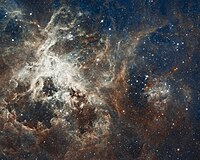Jupiter at its brightest in 47 years
Sunday, September 19, 2010

Image: NASA/JPL/University of Arizona.
The planet Jupiter will be at its closest to the Earth since 1963 tomorrow and Tuesday, scientists say. This will cause the planet's appearance to peak at a brightness and size not seen since then. The planet Uranus will also make a close approach, but will be more difficult to spot, as it is much farther away.
Scientists say that Jupiter will rise at about the time of sunset and will be nearly directly overhead at midnight. The only brighter object that will be in the sky at that time will be the moon. NASA scientist Tony Phillips said "Jupiter is so bright right now, you don't need a sky map to find it." It will not appear this bright again until 2022.
Jupiter will pass within 368 million miles of Earth at the time of closest approach. Although this will occur on Monday and Tuesday, it will remain large and bright for approximately another month.
During this event, the planet will be located in the sky not far from the moon. Some of the planet's own moons will be visible with the aid of a telescope or binoculars.
According to NASA scientists, Earth-Jupiter encounters occur about every 13 months. Since both planets' orbits are slightly elliptical, meaning they are not perfect circles around the Sun, the distance varies in each encounter.
Jupiter, the largest planet in the Solar System, is the fifth planet from the Sun and is more massive than all of the other planets combined, about 318 times as massive as the Earth.
Sources
- Venugopal Rao. "Jupiter closest to Earth since 1963; to appear big and bright" — Bharat Chronicle, September 19, 2010
- Neka Sehgal. "Stargazers to spot the brightest Jupiter in 50 years" — The Money Times, September 19, 2010
- "View giant planet Jupiter on Tuesday" — The Olympian, September 19, 2010


